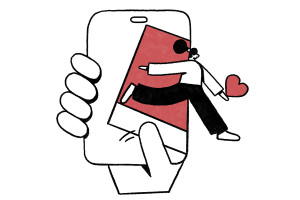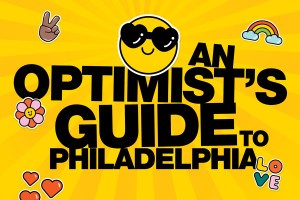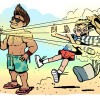North Philly on Foot
The trash is always stunning, maybe the most stunning thing. Cigarette butts, paper, junk. But that, too, is just cultural, mere habit, a way of life. The other thing, the mix of lives on open display, that’s stunning too.
I pass a rowhouse in the shade of a poplar. It has a brilliant lime-green door. Bamboo shades. Soft blue GTO from the late ’60s with a white top out front. A few doors up, on the other side, there’s a padlocked cement workout area with huge rusty weights. A lot of them. It looks like a prison yard. Just south of Cecil B. Moore on 4th Street, Louie and Miguel sit side by side. I say hello. They nod. Louie is very dark. He has missing teeth; he’s 60, maybe. Miguel is young, quiet, intense. Sitting at adjoining open doors, they are so close they could lean against each other in the awful heat.
I’m taking a walk, up into a part of Philly where I never venture. It has always struck me as odd that we have a view, a definition, of “Philadelphia” that ignores swaths of the city in the north and west and south. It’s the Fourth of July, Sunday. The right day to take a different route.
I cross Cecil B. Moore, and stare past a chain-link fence into a vacant lot strewn with building trash, broken sheetrock, chipped blocks, and the crazy flotsam of lives: a woman’s slipper, half of a child’s heart-shaped pink box. Across the street, a family is having a barbecue on the edge of a cleared-off lot; I go to them, and say hello to a Latino man with an open face.
“He doesn’t speak English,” a Hispanic woman tells me. But she’s more than willing.
Her name is Maria. She is 32. Her children bounce near us: They are 13, 10, 7, and 4. Their father is disabled, on Social Security. Maria has lived in this neighborhood all her life. In fact, she owns the rowhome next to the empty lot with the trash, dumped there by a contractor who lives around the corner. She’s told the city about him. They don’t do anything.
The lot where they’re having a cookout has shorn grass, but paper and butts and wrappers have gathered at our feet like a tidal fringe of seashells.
I ask her how the neighborhood is doing.
“It’s 90 percent improved, the drugs,” Maria tells me cheerfully. “I’m concerned about murders—there was one recently at 4th and Girard. Two years ago, my 11-year-old was almost shot. They came around the corner shooting—there’s a methadone clinic a block away, run by the city. The clinic is wonderful, but people who come, they live elsewhere. Some come here to get a fix … ”
This lot, Maria tells me, while her youngest spritzes a tied-up pit bull puppy with water, gets cleaned up by the city every other week; the city took it over from the owner who didn’t pay taxes. Still, the garbage blooms. She asked Fairmount Park workers for trash bags last summer—they never got back to her. “We had trash cans,” Maria says, “but somebody took them. I wouldn’t mind cleaning it up.”
Meanwhile, to celebrate the 4th, she’s barbecuing ribs and chicken, and she’ll make rice and mashed potatoes. There’s chips and ice cream for the kids. They’ll go see the Parkway fireworks later. As I’m about to shove off, Maria asks me if I’d like a rib.
I smile no, and slip north, on my walk.
It is none of my business, of course, to feel sorry for the apparent hardship of her life; but what is apparent, all over the neighborhood, is how hemmed in the folks here in Kensington feel, by people allowing the garbage of their lives to spread willy-nilly wherever. By a city that doesn’t respond.
I veer up a side street and meet Hispanic neighbors Victor, Linda and Ruth, hanging out on the holiday.
“It’s tough to clean everyday,” says Linda, gazing at the trash all over. “It’s the kids … ”
Drawing on a Marlboro, Ruth has been here 24 years: “How it changed? More cleaner. People more nicer.”
And safer, they agree.
Though Victor, handsome, 40-ish, with small, perfectly straight, very white teeth, warns against sweeping hope: “We got drugs—there is plenty of drugs. And a guy put trailers in the lot behind me. There’s high grass there, and rats. The city doesn’t clear it.”
Ruth nods at a warehouse that takes up the entire next block. “There’s like a food market there, with fruit stands, the owners are Asian, they throw rotten food out, and it reeks bad. I don’t think they change the Dumpster.”
Linda: “So many fruit flies in the house, couldn’t open the windows.”
A guy sifting by in a pickup truck smiles—I go over to him, he hands me a business card: Ray is in the used furniture business. He’s 49 years old, and been living here for 42 years. His house is a sharp row that’s been rehabbed. He points up the block: “They just sold that house for 250, used to be 60, 70 here. Compared to what this neighborhood was seven years ago, it changed.” I ask him where the drugs are now. He says 5th and York. “That’s a heroin corner.”
“You won’t have a problem there unless they think you’re a cop,” Ray says. “You look like a cop.”
I look much more like an aging hippie than a cop; I forge north. A mother and daughter play piggyback. Two cars are angled into a corner to jump-start a van. All over, fire hydrants spew.
At 5th and Diamond, the side of a rowhouse sports a gorgeous mural—the entire side of a three-story—of sunflowers, lilies, popping with light and energy. I slip past the front: It is windowless.
Another side of a row: GOD WILL BE HERE SOON.
Black folks out on the 4th of July, barbecuing with barrel cookers, working on their cars, kids in tiny plastic pools—they all stare. I take to the middle of 5th, roped off for picnics with police tape, waving to neighbors on stoops as if I’m some kind of celebrity. (As if I’m Pat Croce: He used to ride through North Philly as something of a folk hero, because of his connection to Allen Iverson.) I get a few tepid nods.
What am I doing?
Heading up 5th to York, of course. There it is, just ahead; I pass a small knot of tough-looking women, surrounded by little kids. At the corner, I peer around, down York—a half dozen men in a group just down the block. I don’t approach. Another group of men on York on other side of 5th. I don’t get near them, either. Not people to say hello to, to wish a happy 4th. I’ve come to the end of my walk.
But—
I go back to the women. Only one is left, as a child or two hangs around her; she’s a heavy girl, maybe 20, wearing tight pink shorts. I tell her I’m just walking around, saying hello on the holiday. She looks at me like I’m from Mars. I tell her my name. She tells me her name. It’s Vanilla. I shake her hand. Then I move south.
Just north of 5th and Cecil B. Moore, a moment out of central casting: He’s as beautiful as Tupac and as hard, wearing low shorts, exposed white boxers, no shirt, wired for sound, coming the other way. I nod and say hello. He looks at me like I’m nothing. We’re right at a huge wall mural:
THE BADLANDS
A mural with:
Roses
A gun
Bullets
A skanky woman in a low white halter dress, her eyes closed. And a skeleton in a suit.
On the Fourth of July, this mural is devastating. I’m in a world so foreign, I can’t approach it. I am unbelievable to Vanilla, and nonexistent to Tupac. What could I possibly want? The guise of toughness flattens people like me. As I move south.


